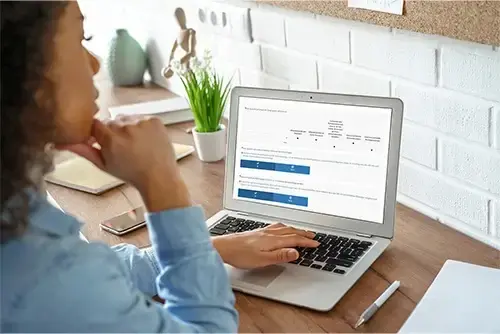Increase Your Blended Learning Efficiency with Learning Analytics

In today’s education landscape, blended learning is becoming increasingly important. The combination of digital learning phases and classroom training offers flexibility, efficiency, and didactic advantages, but also presents organizations with new challenges in measuring success.
Learning analytics (educational controlling) is the instrument that enables companies to systematically measure and manage the effectiveness of their blended learning programs. By accurately capturing data on learning progress and behavior, learning analytics makes it possible to optimize content and demonstrate return on investment (ROI).
What is Learning Analytics?
Learning Analytics refers to the systematic process of assessing and evaluating the success of training measures. It’s about measuring the effectiveness of training programs and ensuring that the investment in employee education brings real value. The goal is to make data-driven decisions about future training initiatives and thus sustainably increase employee competencies and efficiency.
Effective educational controlling helps answer the following questions:
- Have employees acquired the intended skills?
- Are the newly learned skills being applied in the workplace?
- How does training contribute to overall business success?
Benefits of Learning Analytics with an LMS
A well-structured learning analytics approach offers organizations both economic and educational advantages. By combining an LMS with modern analytics tools, training initiatives can be managed in a targeted and efficient way:
► Measurable Learning Success: Transparent tracking of progress & competencies
► Efficiency & Cost Savings: Automated evaluations, reduced resource use
► Strategic Development: Identify training needs & support targeted growth
► Ensure Compliance: Continuous monitoring of mandatory training & certifications
► Boost Motivation: Feedback & personalized learning paths increase engagement
► Continuous Optimization: Data-driven improvements of training programs
Key KPIs for Measuring the Success of Blended Learning Programs
To evaluate both the effectiveness and the cost-efficiency of blended learning, specific KPIs are essential. These metrics provide insights into the quality and impact of training initiatives:

| Completion Rate: | Percentage of participants who successfully complete the blended learning program. |
| Average Learning Time: | Time spent on digital modules and classroom phases. |
| Knowledge Gain: | Results in knowledge checks and micro-assessments. |
| Participation & Engagement: | Level of activity in webinars, forums, and classroom sessions. |
| Feedback & Satisfaction: |
Learner evaluations via surveys and feedback tools. |
How TCmanager® LMS Optimally Supports Learning Analytics in Blended Learning
TCmanager® LMS provides a powerful technological foundation for combining blended learning with systematic learning analytics. The platform not only manages and organizes learning formats but also supports comprehensive analytics and micro-assessments for precise success tracking.
- Automated Tracking: Monitor learning progress in real time across all formats.
- Individual Learning Paths: Adaptive learning paths automatically adjust based on results.
- Reporting & Dashboards: Intuitive visualization of KPIs and detailed reports support decision-making.
- Resource Planning: Automated scheduling of trainers, rooms, and materials aligned with hybrid learning paths.
- Integration of Classroom & Digital Data: Combine both data sources for a holistic perspective.
Practical Examples: ROI & Learning Success through Learning Analytics in Blended Learning
Organizations using TCmanager® LMS with integrated learning analytics achieve measurable improvements:
- Reduced training costs through targeted blended learning while increasing learning quality.
- Higher completion and success rates through adaptive learning paths and individual support.
- Simplified tracking of qualifications and certifications with automated reminders and scheduling.
- Continuous optimization of programs based on reliable reports and KPIs.
Frequently Asked Questions (FAQs) about Learning Analytics & Blended Learning
- What is learning analytics in the context of blended learning?
It refers to the systematic measurement, evaluation, and management of training initiatives to optimize their effectiveness within blended learning programs.
- Which KPIs are most important for measuring success?
Key KPIs include completion rate, learning duration, knowledge gain, engagement, and learner satisfaction.
- How does TCmanager® LMS support learning analytics?
TCmanager® offers extensive analytics and reporting tools, adaptive learning paths, and automated tracking for precise performance measurement.
- How can the ROI of blended learning be calculated?
ROI is determined by comparing training costs (digital and classroom) with measurable benefits such as learning outcomes, efficiency gains, and cost savings.
- How can long-term learning success be ensured?
Through adaptive learning paths, continuous monitoring, and a mix of assessments, feedback, and on-the-job observations.
Ready for the Future?
The educational landscape is changing rapidly. Be prepared to implement innovative solutions and seize the opportunities that arise. Utilize the possibilities offered by modern seminar management software and LMS to optimize your offerings and meet the needs of your participants.
Free Demo & Consultancy
Discover how TCmanager® LMS can revolutionize learning analytics in your blended learning programs.
Let our experts show you how to make your training success measurable with powerful analytics.
Call +49 (0)89 / 309083930 to arrange for your free consultancy.

About Us
Since 1998 SoftDeCC is working closely with major training centers and academies. This results in a unique experience with training requirements.
Our Learning Management System TCmanager® is designed to adjust to individual corporate learning processes and address evolving challenges. More...








